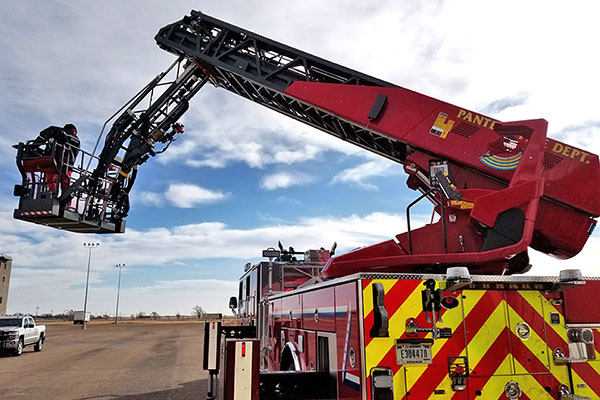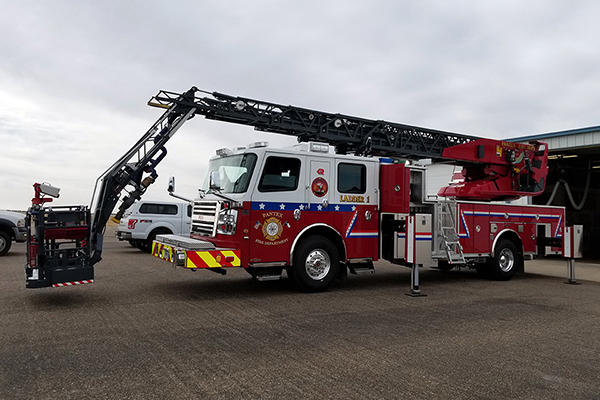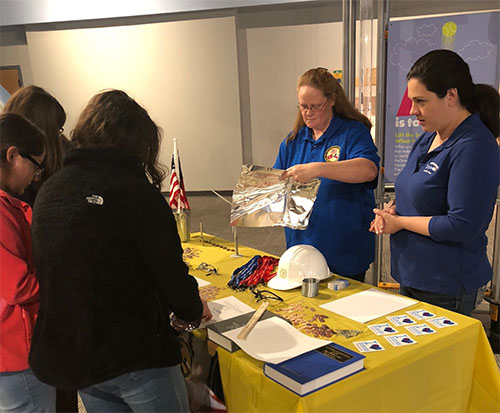Pantex Blog
Celebrating Earth Day every day
There is no Planet B, so Consolidated Nuclear Security, LLC focuses on recycling everything from regular office paper to electronic equipment and scrap metal. In Fiscal Year 2017, employees at Pantex and Y-12 recycled more than 4.6 million pounds of materials, demonstrating their commitment to environmental stewardship.

Wild Pantex- Unlikely Comrades: Badgers and Coyotes
Article by James D. Ray, Pantex Wildlife Biologist/Scientist
Natural Resources staff at Pantex has spent a lot of time working within the boundaries of colonies of black-tailed prairie dogs. This has included annual mapping of colony boundaries, spotlight surveys for wildlife, standardized surveys of vegetation and birds, and many projects conducted in collaboration with Texas Tech and West Texas A&M Universities.
One of the most interesting observations ever made by Natural Resources staff at Pantex occurred within a prairie dog colony in mid-summer of 2003. Three of us were in the field collecting data that would later be used to estimate the number of prairie dogs occupying the colony. From west to east, I was conducting counts during scans of my assigned area from a pickup truck, while Monty and Mike were scanning from their elevated perches in blinds normally associated with deer hunting. The procedure required several scans spaced throughout the morning and upon finishing and meeting up, Monty and Mike could hardly contain their excitement about a scene that unfolded first in Monty’s area, and then in Mike’s.
While performing their counts, Mike and Monty observed a badger and young coyote traveling and, apparently, hunting together. At first, there was one coyote and one badger, each one leading at times during their walk. The coyote would occasionally give chase to some small quarry and, unable to keep up, the badger would fall behind. However, as they crossed Mike’s area the parade grew to include five juvenile coyotes and then, after being joined by two adults, seven! Occasionally, the badger would stop and dig, and the coyotes would watch intently as to be ready for anything that might escape the badger.
Upon reaching my office, I immediately began conducting a literature search, expecting that these observations might be of interest to the scientific community, and publishable. Much to my surprise this “association” was well published and, in fact, was the basis of Native American legends.
In preparation for this blog some fifteen years later, I found mentions of badger and coyote associations from many areas in Canada, the United States, and Mexico. Some even included trail cam video or still photos. Behaviors observed by Mike and Monty were consistent with the sources, but recorded observations mostly involved one badger and one coyote, sometimes two and, rarely three. Most often the prey involved ground squirrels or prairie dogs.
Even today there remains some question as whether or not this not-so-rare association is mutually beneficial to both the badger and coyote. One study demonstrated that coyotes have chances at one-third more prey when hunting with a badger verses when hunting alone. Prey that escape the badgers’ attempt to dig them out of burrows are pounced upon by the coyotes at a fair level of frequency. Perhaps, also, the badger may obtain additional chances if these escapees manage to survive the coyote’s attempts of capture and are able to slip down a hole. The coyote’s chase and subsequent interest in the hole may alert the badger quickly to where there is potential food, thus negating the badger’s need to spend time and energy searching holes and areas for a meal. Regardless, the two species display a fascinating association with each other.
It is just my luck that from my vantage point I was not able to share in Mike and Monty’s observations that day. But it is good to know that our Wild Pantex can still reveal new things to me, and that our landscape can still host scenes of which history recorded long, long ago.
Please feel free to share this link with others that enjoy wildlife or that appreciate entities that take great strides to contribute to wildlife conservation.
Pantex gets new fire truck
Pantex has a new fire truck that was built customized to input provided by Pantex fire department members.
The new Administrative Support Complex requires that the Pantex Fire Department be able to reach the third floor in the event of a fire, but the current equipment would only reach to the top of a two story building. Knowing that is would be a requirement, the fire department set the gears in motion for a new fire truck with a ladder a little over a year ago.
“We really started thinking outside of the box with this truck,” said Robert Napp, Pantex Fire Captain. “Knowing we needed something that would reach the top floors at the new building, the Fire Chief wanted the most capable piece of equipment we could get that would fit in our station. We started talking about what would be useful for us during rescues — how could we get the most bang for our buck.”
The new truck was built in the United States, but the 102 foot ladder that sits atop the truck was made in Germany by a company that has been in the business of making ladders for fire trucks for more than 100 years.


Pantex hosts inaugural Introduce a Girl to Engineering Day
Pantex recently celebrated Engineering Week 2018 by hosting the Introduce a Girl to Engineering Day conference for more than 100 area high school girls. The event, organized by the Pantex Women in Nuclear (WIN) organization, featured interactive presentation booths and plenary sessions by women leaders in STEM fields. Consolidated Nuclear Security, WIN, and Pantex Outreach and Leadership Organization (POLO) hosted the inaugural conference in partnership with the Don Harrington Discovery Center, West Texas A&M University, Texas Tech University, Asarco, Texas Alliance for Minorities in Engineering, and Bell Helicopter.

Wild Pantex – The Owls of Pantex
Article by Jim Ray, Pantex Wildlife Biologist/Scientist
Hearing a pair of Great Horned Owls calling back and forth recently prompted me to write about the owls we have documented at Pantex. The all-time bird list for the 18,000-acre Pantex Plant includes five species of owls: the Barn, Burrowing, Great-Horned, Long-Eared, and Short-Eared Owl. Although their diet includes more than just rodents, owls play a huge role in helping to keep rodent populations in check. Owls are amazing creatures, with some species being able to hunt in complete darkness and catch prey based on sound alone.
Following is a little information on each of the owl species that have been observed at Pantex:
Barn Owl - This medium size owl’s scientific name, Tyto alba, translates to “white night owl.” This owl is fittingly-named, because it appears “ghostly white” while in flight. It is white on the face, body, and underwings and pale buff and grey on the head, back, and upper wings. Their raspy call can be heard at night as they hunt over open habitats searching, primarily by sound, for small rodents. Barn Owls raise one to three broods per year in cliff, cave, and tree cavities, or in buildings, deer blinds, and other human structures. Several pairs nest every year in buildings and other structures at Pantex.
Burrowing Owl - This small, long-legged owl’s scientific name, Athene cunicularia, translates to “wise one who dwells under the earth.” As its name implies, this brown bird mottled with sand-colored spots nests in holes in the ground. The western subspecies found here in the Great Plains is most often associated with colonies of black-tailed prairie dogs where they will raise a brood each year in a burrow originally dug by prairie dogs. Burrowing Owls are quite common in Pantex prairie dog colonies and have been the subject of several studies in collaboration with Texas Tech University.
Great Horned Owl - This large, thick-bodied owl’s scientific name, Bubo virginianus, translates to “owl of Virginia;” Virginia being where the first Great Horned Owl specimen was collected. As its name implies, this owl has large ear tuffs (feathers). The Great Horned Owl’s coloration is mottled gray brown, and it has a white patch on the throat. However, its coloration varies across its range and includes populations that are more “sooty” (far north) and even “mostly white” (Arctic) in coloration. The Great Horned Owl re-strengthens or forms pair bonds in the fall and early winter, and this involves hooting duets where each hoot results in a reply by its mate. The male has a lower pitched hoot than the female. Great Horned Owls do not construct nests, but rather use nests built by other large birds or squirrels, or the existing substrate in broken snags, cavities in cliffs, caves and trees, or in buildings and other human structures. Great Horned Owls begin nesting early and I have found females on nests as early as mid-January here in the Texas Panhandle. A pair or two nest in structures here at Pantex every year.
Long-Eared Owl - This owl’s scientific name, Asio otus, translates to “small owl with ears.” This owl is a medium-sized owl that looks similar in coloration to the Great Horned Owl. However, it is much more slender, its head more square in shape, and it actually has longer ear tuffs than the Great Horned Owl. Other key identifying characteristics are buff or orange coloration of the Long-Eared Owl's face and the fringes of the ear tufts. This bird’s inclusion on Pantex’s all-time bird list is limited to a single observation involving a lone Long-Eared Owl perched in a willow tree. The bird was not observed again and was likely just passing through.
Shored-Eared Owl - This owl’s scientific name, Asio flammeus, translates to “eared owl with fiery plumage.” This wintertime visitor to the southern U.S. is brown, spotted with buff and white on the underparts, and has heavy streaking on the breast. The Short-Eared Owl has a relatively long wingspan and small, closely-spaced ear tufts. However, the “ears” are normally concealed by feathering, only becoming conspicuous when the birds become excited. I love seeing these owls, which we sometimes flush from grassy cover while conducting fieldwork and we often see a few while conducting our spotlight surveys for wildlife.
Owls are among the many types of wildlife that call our Wild Pantex home.
